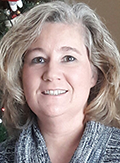Notes from Region 1
 Christine Quisley
Christine Quisley
MCTM Region 1 Director
K-12 Math Specialist District 241 – Albert Lea
As I write this in early January, the Minnesota winter is going strong. It is a balmy -15 degrees outside. We have just returned from winter break, anxious to begin the second half of the year. I have the pleasure to work with a fantastic team of teachers here at District 241 in Albert Lea. Over the last three years that I have been here at Albert Lea, I have seen a huge, positive impact with student understanding of mathematics. I believe that is due to multiple reasons; however, the one I want to share today is how important a math-positive culture is to success.
Our teachers are committed to ensuring that their students learn mathematics. This may seem like a small thing, but trust me, it is not. In my past when working with districts to define what learning looks like and sounds like for our students in the area of math, it can become more of a laundry list. At our four elementary schools, we have taken the step to make sure we think about the whole child and all aspects of learning. Some of the items we think about concerning the environment of our rooms are: is it pro-math, is there easy access to materials for all students at all times, is the atmosphere present that mistakes are great and we cannot learn to our highest level without making them? Then we support everyone to make this happen everywhere, meaning students are learning from students, teachers learning from students, and students learning from teachers.
I have had the pleasure to work with many teachers; however, two specific classrooms at two of our buildings come to mind as I write this. These teachers have embraced this mind-shift in how we learn math concepts. These teachers were at different places in their educational journey, one with a few years’ experience and one mid-stride in the journey. Both of these teachers felt that math was going okay within their rooms and had no real concerns with anything when we started conversations about what mathematics learning looks and sounds like. However, what they did want was more; each lesson, each interaction with students could be more. When I followed up with what they meant by “more” they described it as math needed to be involving the students not just something we present to them or something we “do” to them. Exactly! Too often, many of us teach the way we were taught, and let us face it those my age (plus or minus 50) were probably taught math as a rote subject where memorization was the key strategy. Today, we want teachers and students to understand the “why” of math, the importance of interaction within math time, and the use of tools to ensure learning is making sense. In short, we want a math-positive, student-centered focus, where learning happens due to students getting messy with the math.
We recently adopted a new textbook where one of the main components is for students to solve and share how they solved the problems with each other. At first, a majority of our students struggled with this because we had never asked students how they solved the problem. We asked, “What did you get for an answer,” not how you thought about the problem to get an answer. Teachers were overwhelmed with all of the “I just knew it” or “I thought it in my head.” What we learned is we need to help students explain their thinking. These two teachers, like many in our district, embraced this aspect by giving up control of the class to gain control of the learning. What I mean by this is the teachers started talking less and asking many questions, leading to students gaining more confidence in sharing their thinking and strategies on how they solved problems. It was and continues to be amazing! Students want to share, and they want to help others learn their way and learn new ways. This is where and how tools came into helping students be able to represent their thinking. Students saw that the way Julio added 3 + 4 was the same as the way that Tanner added. They also saw that Lindsey and Emma flipped it and started with 4 + 3, but the results were the same. Students worked in groups at desks, on the floor, standing at tables – wherever it worked for them. Learning is happening because of what and how students are able to interact with the math.
This may sound like a simple change, just ask more questions and get out “stuff” for students to use. What I can say for sure is it is not. It takes purposeful planning and knowing your students. You need to think what tools will help them be effective and efficient in their thinking. What questions do I need to ask to keep promoting the learning instead of stopping it? It is a process that everyday gets better, and it is why these two teachers keep having success. They realize each of their students is an individual and brings knowledge to the conversation. It is the figuring out how to give children that voice to share their knowledge that takes planning and structure, and keeps all our teachers striving for more.
